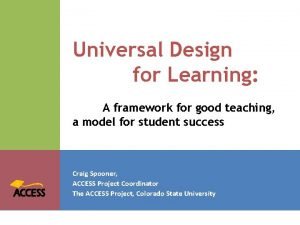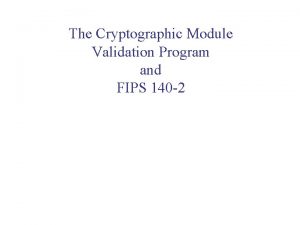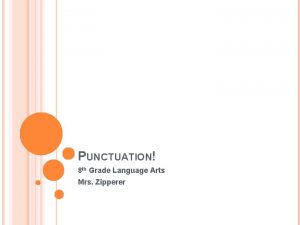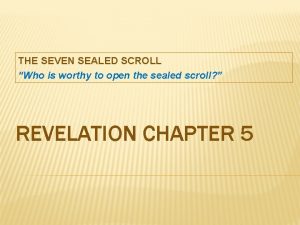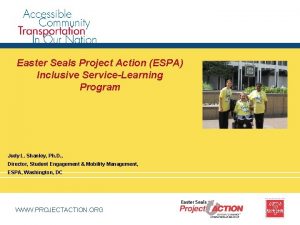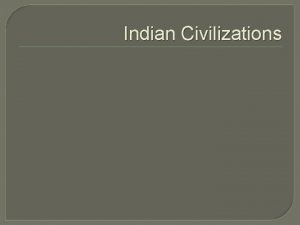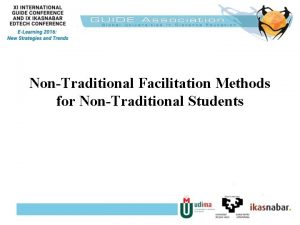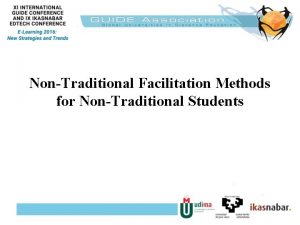NonTraditional Activities to Engage Youth Nashona Andrade Seals
















- Slides: 16

Non-Traditional Activities to Engage Youth Nashona Andrade Seals

WELCOME!!!! • Overview • Upcoming Training SDCOE • Training on Your School Campus • OMH Background • I Am A Locksmith • Q&A

OMH Background Founder • OMH • Storytelling • a. Creative Writing b. Reflective Art § Non-Traditional Activities to Engage Youth

GOALS 1. Bridge gaps between the youth community and professionals through creativity and innovation 2. Offer activities that promote collaboration between youth and professionals 4. Increase positive outcomes for students through creativity 5. Offer an alternative language from which to communicate (art/writing) 5. Add a bit of flare to current practices 6. Encourage a higher percentage of student engagement by using nontraditional activities that support social and emotional development

Rules of Engagement (Building Trust) a. b. c. d. e. f. g. h. i. Connect through partnership and collaboration to establish credibility. Let go of the need to control Be Consistent with expectations and boundary setting Be Vulnerable Be Transparent within professional boundaries Learn the emotional language of your youth community Celebrate ALL achievements Be willing to accept responsibility for your mistakes Know when to take a break, step back, and ask for help

The 5 S’s 1. Set Up- Introduce activity/activities through a brief overview. This will help to set expectations. If you’re using the medium of art, have a completed example of the visual work. 2. Stimulate- Keep student/s engaged in the activity through music, video, poetry, quotes 3. Show Up- Make yourself transparent, vulnerable, available. The goal is for them to let you in by choice, not by force. Sharing a little about yourself will allow the student/s to give you their access codes without the need for hacking. 4. Supply Materials- Prepare and gather supplies before the activity is launched. Explain the intended use of each material. 5. Support- Encourage participants to continue the work through ongoing support, asking questions, and dialogue.

Non-Traditional Activity Examples 1. Dialed In- Using apps on our cell phones to manage messages from our inner voice. In this activity we teach our participants how to filter, adjust volume, organize, and navigate through challenges, through positive messaging. This activity can be adjusted to incorporate mindfulness and address internal conflict. 2. Designated Driver- Consciously controlling our movement through struggle to arrive at our strengths, and understanding the relationship that strength and struggle share. This activity can be done in group or individually, and can be used as a tool for semester goals-short and long term. 3. Frequencies- Identifying the impact that repetitive and inaccurate messaging from the media, can have on our self perception, and its connection to low self-esteem, depression, bullying, and unhealthy relationships. Additional topics that can be addressed using this activity include body Image, race, gender bias…This activity can be done in group or individually.

I Am A Locksmith Overview: You are a locksmith. As a locksmith, you have the ability to construct, replace, and master skills (keys), that lead to your greatest potential. Key functions can be Social, Personal, and Academic, and should highlight the following: 1. Skills you’d like to unlock and develop (Construction Keys) 2. Skills you have mastered, are confident in, and or good at (Master Keys) 3. Skills you have misplaced and have a hard time accessing regularly (Misplaced Keys) Social and Emotional Focus: Accountability, Self-Esteem, Self-Care, Self. Management, Decision Making, Introspection, Responsibility, Awareness, Empowerment, and Reflection

I Am A Locksmith Stimulate (S 2): Suli Breaks- Parents are the Hardest People to Please||Spoken Word https: //www. youtube. com/watch? v=7 Uc_mvw. OUf 0 Show Up (S 3): My master keys-Nashona Andrade Seals

I Am A Locksmith Supply Materials (S 4): A. I Am A Locksmith Instructions B. Worksheet C. Pencils I Am a Locksmith Instructions: You have eight keys and one lock on your worksheet. Three Master Keys, Two Construction Keys, and Three Misplaced Keys. 1. (Master Keys)-The three keys above your lock, are designated for skills that you’ve mastered. These represent skills you’re confident in, and or good at. Examples include: follow through, self-care, writing, and playing instruments. Write one word, per designated key to identify these three skills.

I Am A Locksmith Directions Continued… *You may duplicate skills in each section 2. (Construction Keys) The two keys in the center of your worksheet (one on each side of your lock), are designated for skills you’d like to develop and unlock. In other words, these keys represent skills you’d like to develop or acquire. Examples include math, communication, organization, trust. Write one word, per designated key to identify the two skill you’d like to construct. 3. The three keys beneath your lock, are designated for skills you’ve misplaced and have a hard time accessing regularly. These skills would be those that you’re good at using sometime, but other times you struggle to find and use them properly. For example, follow through on assignments, patience with self/peers/teachers/family, speaking up for yourself, anger management, forgiveness. Write one word, per designated key to identify these three skills.

I Am A Locksmith Support (S 5): Encourage participants to continue the work through ongoing support, asking questions, and dialogue. Extend the Work: Students can use the reverse side of their worksheet to write about their challenges, successes, and overall experiences with their skills/keys. Ask them how and why they’re able to acquire skills in some areas easier than others. Get them to think deep about situations, support, personalities, interests, their mood and emotional status, and how those things impact their ability to acquire skills. At the end of the week, month, or school year, a celebration of skills can be had by making a key ring of successes, and offering a certificate of achievement!

I Am A Locksmith Supportive Questions: 1) 2) 3) 4) 5) 6) How do you maintain your skills? In what situations, do you struggle to find your skill sets? When do you use your mastery skills the most? How can you transfer the skills you’ve mastered to other skill areas that may need further development? Who are your accountability partners? What makes them so reliable? Who do you depend on when your accountability partner is not available? What characteristics do you share with your accountability partner? When do you need them the most? How can I support you?

I Am A Locksmith Things to Consider: -This worksheet/activity can be done weekly, monthly, or at the beginning of the school year. -If using the activity on a weekly basis, you can focus on each designation (Skills Mastered, Skills Constructed, Skills Misplaced). -This activity can be completed as a group. The activity can be centered around group goals and can be used as a checkpoint at the beginning of every session or meeting. -Sometimes, kids, have a hard time coming up with language or words to associate with their needs or skill sets. If this is the case with your student population, identify a pool of words for them to choose from ahead of time.

Q&A

THANK YOU!!!
 Nontraditional manufacturing processes
Nontraditional manufacturing processes Udl nontraditional students
Udl nontraditional students Disney cruise line youth activities counselor
Disney cruise line youth activities counselor Fips 140-1
Fips 140-1 Seven seals of revelation
Seven seals of revelation Types of sealants used in automotive
Types of sealants used in automotive Heritage swim club
Heritage swim club Characteristics of seals
Characteristics of seals Stop clubbing baby seals punctuation
Stop clubbing baby seals punctuation 7 sealed scroll
7 sealed scroll Signs and seals of the covenant
Signs and seals of the covenant Pei easter seals ambassadors
Pei easter seals ambassadors Easter seals project action
Easter seals project action Ppc mechanical seals
Ppc mechanical seals Harp seals life cycle
Harp seals life cycle Fish thieves take rare seals
Fish thieves take rare seals Red seals sso
Red seals sso

